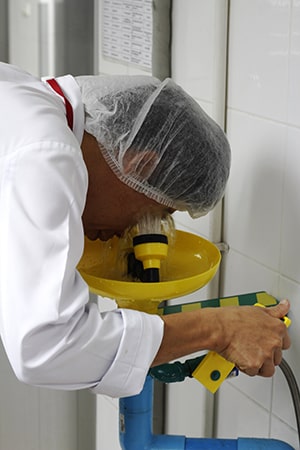Often overlooked in many facilities, emergency eyewash stations play an important role in the safety of workers. Damage to or loss of eyesight can not only be a devastating personal event, but it can also be extremely costly for the employer. Permanent injury is all too common when flying debris or, worse yet, caustic chemicals impact the soft tissue of the human eye.

Recently, I was asked to provide a workplace assessment in a large manufacturing facility. One of this company’s main concerns was eye safety due to the processes taking place in this plant. There were multiple portable eyewash stations in various locations around manufacturing areas.

OSHA says, 29 CFR 1910.151(c) states: “Where the eyes or body of any person may be exposed to injurious corrosive materials, suitable facilities for quick drenching or flushing of the eyes and body shall be provided within the work area for immediate emergency use.”
- A minimum ten-second walk from eye hazards (imagine walking while blinded in an emergency)
- A clear path of travel from hazards to the eyewash stations
- A 15-minute flush of tepid water at .04 gallons per minute flow rate
- Mounted so that the flush area is a minimum of 33 inches from the ground, but not more than 53 inches from the ground
- Portable units should be cleaned and have the water checked weekly
- An annual complete inspection is required (flow rate, water temp, the condition of valves and spray heads)
- Plumbed units should have a mixing valve to provide water temp between 60- and 100-degrees Fahrenheit
- The spray heads must be protected from airborne debris and not require a separate action to remove the protective caps (activating
the spray should remove the caps)
- The inspection tag should be visible with date and signature of the inspector (just like your fire extinguishers)
- Activation valve must be of the “stay open” type and only closed through a secondary action
- A clearly visible sign is required to identify each eyewash station

The above list contains the most overlooked requirements of emergency eyewash stations. The best source for the complete requirements can be found in the ANSI standard Z358.1.
There are now many manufacturers of both permanent plumbed and portable gravity fed eyewash stations that meet or exceed OSHA and ANSI requirements. Please reach out for a site survey focused on eye and skin protection. We are here to help!